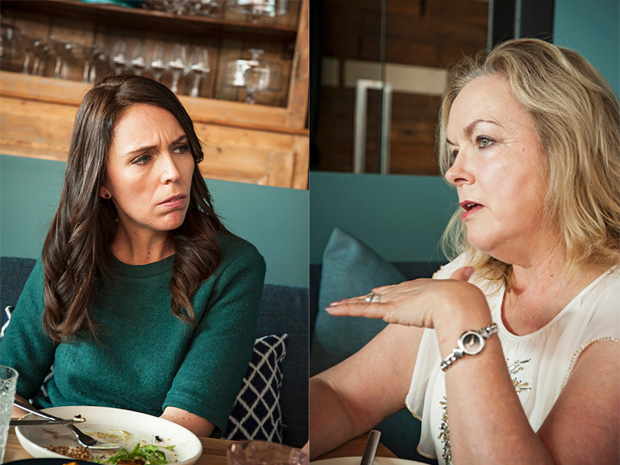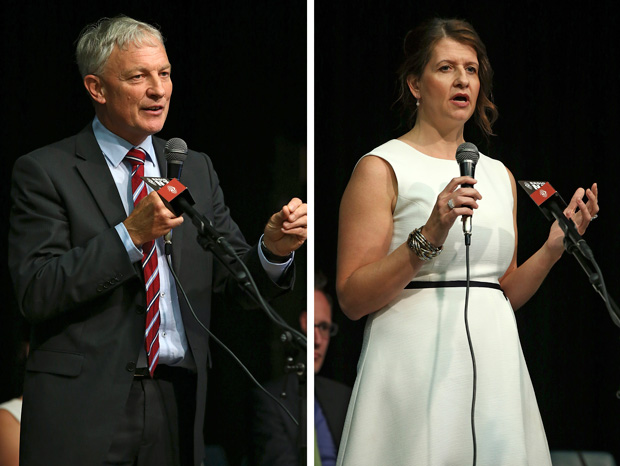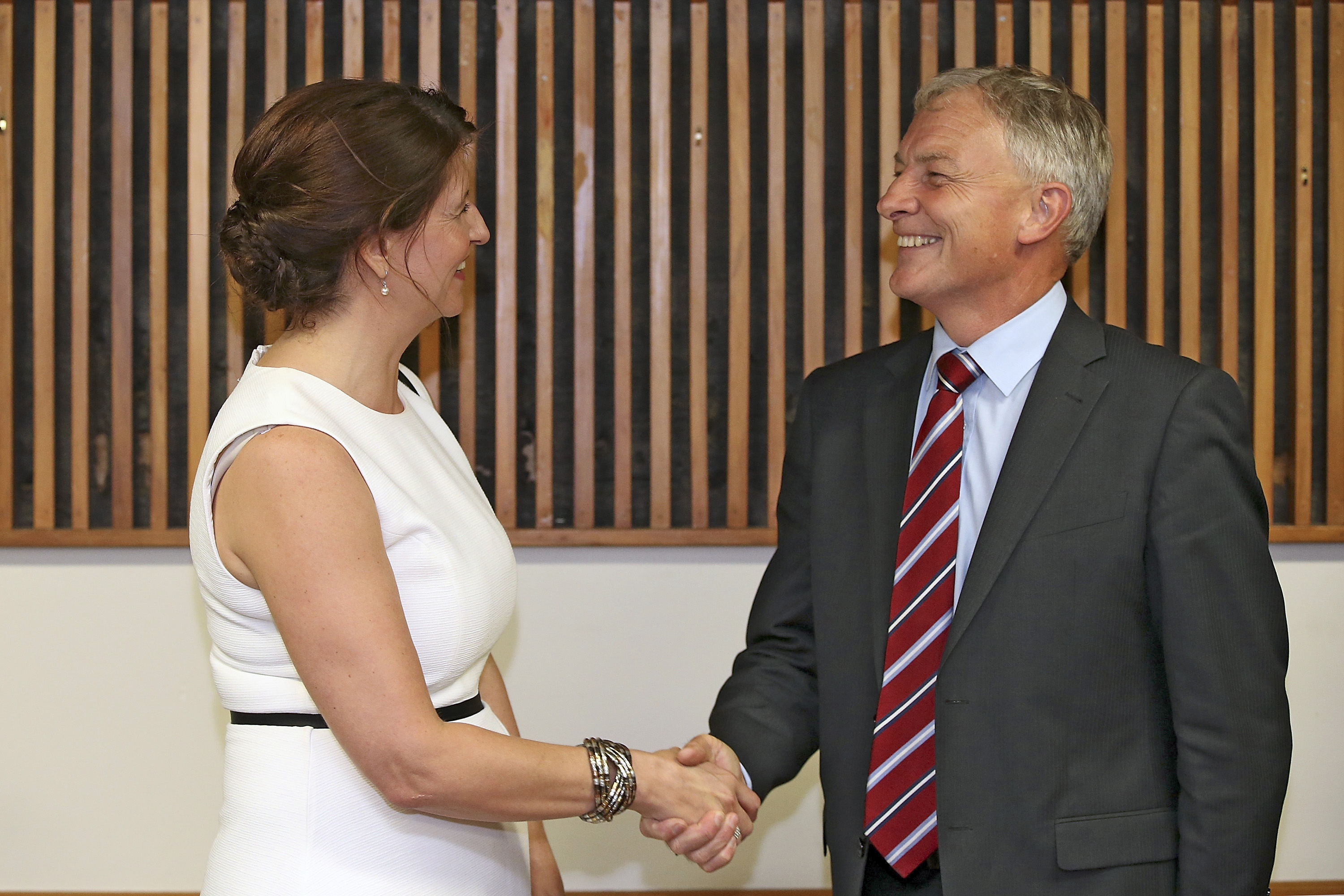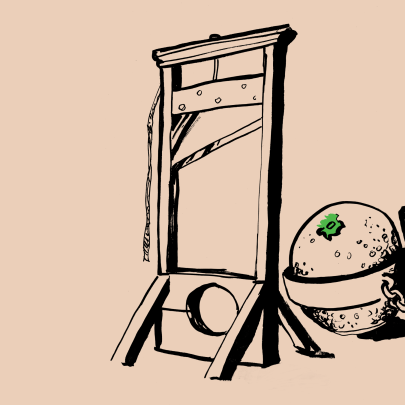Mar 11, 2016 Politics
Excited about Auckland? Worried about your rates? Wondering what a decent mayoral candidate for this city would look like? Welcome to the Metro Mayoral Manifesto.
This article first appeared in the March 2016 issue of Metro. Illustration by Kieran Rynhart.
Caught a green Link bus recently? Inner Link buses run every 10 minutes, supposedly, but sometimes you wait more than 20. Sometimes they travel in pairs. Then they stop along the route to try to correct this. And sometimes, this happens at a stop where the drivers change, so you can’t get off and walk or catch a cab because the departing driver has switched off the Hop card reader.
Is it a problem for the new mayor to fix? You bet it is — for two reasons. First, because it’s important in itself. The Link bus is supposed to be a lynchpin for the entire central-city transport plan: in theory, it is one of the truly great innovations we’ve had. And yet because it is unreliable it undermines that plan.
Second, because fixing the problems of the Link bus will provide a template for fixing a whole raft of other problems, too. The kind of thinking involved, the organisational initiatives required and the outcomes that result will all be applicable, not just to other transport issues, but to mediating the conflicts caused by greater density in the suburbs, providing affordable housing, raising educational achievements… even holding down rates.
Really? Yes, really. That damn Link bus typifies the problems of civic planning in this city, but it also has the potential to show us how good things could be if we got the planning right.
Can the Link bus be fixed? Of course it can. The buses are unreliable because they get stuck in traffic, and planners quite possibly regard that as an insoluble problem. But it’s not. All it needs is this very simple 10-point plan:
1. Privilege the buses. Identify the choke points and solve the problem of each of them: add more bus lanes; convert more of the route for exclusive bus use (like Grafton Bridge and Wellesley St in the block east of Queen St); move the route.
2. Compensate private transport. Add more carparking options at the edge of the inner city, so people can park and ride the Link.
3. Increase the frequency. An “every 10 minutes” service needs enough buses on the route for that to be reliably true.
4. Make the service more enjoyable. What onboard services could be offered to upgrade the experience of riding a Link bus? The aim here: to make a Link ride not just a functional transport option but a valued experience in its own right. Make it into something people look forward to doing.
5. Aim higher. The Link service could be the key way in which workers, shoppers, students and residents move around in the inner city, when it’s too far to walk. Replacing most taxis and most private cars. Sharing the roads with service vehicles and bikes. Comfortable enough to work in, with Wi-Fi connection; frequent enough so when you look over your shoulder you’ll probably see the next bus on its way; cheap enough to use often; cool enough for people to feel proud of it, connected to it, pleased to use it.
People should still be able to drive into the middle of the city. But because they want to, not because it’s the easiest way to get there. It should be easier to catch the bus.
How do we do all that?
6. Promote it better. There’s a terrific advertising campaign waiting to be created, just as soon as the service is improved.
7. Tap the best creative minds. I’m well aware I don’t know enough to solve all the problems: transport planners are probably spluttering apoplectically into their flat whites at my naivety. But as an operating principle, how about this: put a smallish bunch of very creative people in a room, describe the problem and invite them to solve it. Keep doing that. (For more on this, see “Put a bomb under the Office of the Mayor”, below.)
8. Make it someone’s job to get it done. Everybody who’s ever done anything knows that unless there’s someone with the specific responsibility for a project, and the authority to match, it won’t get done properly or it won’t get done at all. That person should be in the Office of the Mayor, along with other powerful, high-achieving enablers. (See “Put a bomb under the Office of the Mayor”.)
9. Introduce congestion charges. The government is blocking this right now, but that will change, one day. The last — not the first — step in the chain of events to make the Link bus the preferred option for transport in the inner city, to be taken after the service itself has been wonderfully improved, is to make it more expensive for cars to visit the centre.
10. Introduce light rail. The 10th point on the Link bus plan is to eliminate the buses. Eventually, it’s possible light rail (aka modern trams like they have in Melbourne and Sydney) will make more sense than buses for this kind of service. Or perhaps it will be electric driverless minibuses? Whatever, when the time comes, it will not be difficult to replace one service with another.
What’s the biggest impediment to this simple plan? There’s only one: it’s the people who say it can’t be done.

Brown & Brown
It’s become so common to be proud of Auckland that we forget how recent the feeling is. But even 10 years ago the prevailing feeling was cynicism.
And yet there’s a disconnect. We tend to think the renewal of Auckland has been due to people like Al Brown, the restaurateur who reinvented what a really good restaurant could be like in this city. True, he’s been great. But he couldn’t have done it without the other Brown: Len Brown, the mayor.
It was Len Brown who led the process of making the city a place to be proud of. He didn’t invent it, and I don’t want to overstate his contribution. He’s embraced the great ideas of others more than he’s led with his own. But so what? As Auckland rethought the relationship of city and sea, converted old buildings into new shopping and office precincts, beefed up its public transport, encouraged the Lantern Festival to grow enormous, bedded in its arts festival, introduced a big range of education initiatives in the south and, yes, enabled a new boom in restaurants and bars, Len Brown got it.
He loved it and he championed it. And that made it all so much easier for the entrepreneurs and officials who really are the people who make it all happen. He deserves credit for it.
More to the point, his programme — to make Auckland a much more liveable city — now needs support. It’s at risk in this election. The centre-right group Auckland Future has said little to suggest it will champion the kind of city Auckland is becoming. And there is now the beginning of what could become a stampede among council candidates on the left and the right, running from attacks over rates and apartment blocks in the suburbs. (More on this below.)
Sadly, the failure of Len Brown’s tenure is that the liveable city programme has not been bedded in. Over the past two years, Brown has not done that because he has not been a respected leader. Instead of defining the discourse, he’s kept his head down.
To their credit, both leading mayoral candidates, Victoria Crone and Phil Goff, appear to be broadly committed to the liveable city programme. Their task now — the measure of their skill as leaders — is to make it an electorally attractive proposition.
Here are eight things they have to do.
The 8-point plan
1. Build consensus on new housing plans
Auckland has a fast-growing population and that has created a massive planning problem. Many new homes will be built on greenfields land: spreading the city further into the country. But for lots of reasons, that can’t be the only way the city copes with the demand.
To meet the needs of people who want to live reasonably close to the centre and those of residents who want to stay in their suburbs as they get older, to make public transport more efficient, to mitigate our impact on the climate and, let’s not forget, to help keep rates under control, we need many more dwellings in the suburbs where people already live.
And yet, as a series of interlocking communities, we can’t agree where they should go. Replace those state houses on quarter-acre sections with townhouses? Infill the large sections of the leafy suburbs? Build intensively in that quarry? Put more apartment blocks in the middle of the “metropolitan centres” like Albany and New Lynn? Allow three-storey townhouses where the previous limit was two? Build dozens more new towns like Pokeno?
Pushed to their extreme, it’s easy to make all those ideas sound like civic vandalism. Which is exactly what many lobby groups already do, and there will be council candidates who follow their lead. It’s unscrupulous, but there are votes in it.
But in moderation, over time, most of those ideas are eminently sensible.
We need a mayor who can create a consensus on how we handle proposals for development. Who will stand up as a champion of smart intensification. Who can excite us and reassure us. Who does two things:
- Wins our imaginative buy-in to the idea of a city where it’s great to live and work. A city that’s vibrant, mixed, full of choices (about where to live and so much else), a place to be excited by, not scared of. They have to lead with a vision.
- Sets up new consensus mechanisms. Should there be a council of interest groups that meets regularly to thrash out proposals? A working group to do the same? Currently, the future of the port is being chewed over by a large “working group” that includes people representing all the different points of view. Should we have more of that?
2. Change council culture
One of the innovations of recent years in Auckland has been “shared spaces”: streets where there are no separately designated carriageways and footpaths. Everyone shares, and restaurants, bars and other retailers are encouraged to use the street as well.
Mmm. In truth, that’s only what you might think happens. Instead, the council stops retailers from putting stalls out in shared spaces and fusses to extraordinary lengths over where cafes and restaurants can put their seating.
Why are shared spaces like Fort St, O’Connell St, Darby St and Federal St — all of them, actually — surprisingly barren? Because while the design office of the council creates new urban spaces for citizens to enjoy, the gatekeepers of commercial activity on the street basically do their best to shut that activity down.
It’s absurd. Fort St is very wide, especially at its eastern end, and is perfect for an outdoor bazaar atmosphere. In O’Connell St, the restaurant tables and chairs often seem almost desperately lonely: why can’t those fashion boutiques set up stalls outside?
As for Federal St, while SkyCity’s wood panelling makes the street look better than it used to, it’s still basically a through-route for cars, with some restaurant tables to the side. At the north end at least, it should be a plaza.
One of the problems is that the council believes pedestrians should be able to pretend there is a footpath, hard up against the buildings, and walk along it in a straight line. We can have shared spaces, as long as we cater for people who don’t want them.
Talk to businesses of all kinds around town and they’ll tell you similar stories. Council officers don’t make it easy.
Those council officers will say they have regulations to uphold. Food safety, traffic safety, the soundness of buildings, noise controls, dog controls… the rules are there for the greater good. That’s very true.
But the council’s role is not just to act as guardian of that greater good. It’s also to enable. The entrepreneurial souls who bring commercial, creative and recreational life to the city should be supported. Council officers should be saying, “Our job is to enable you to get it right and make it good. How can we help?”
It’s not just about shared spaces in the inner city. They’re a very small part of it. But they’re symptomatic: a council that can’t work actively with landlords and tenants to help them realise the potential of urban spaces is a council that does not see itself serving the city.
It’s about council culture. Lots of council officers get it. Lots more don’t.
- The mayor needs the people skills to work with staff, and with the elected representatives, too, to grow the culture of enablement.

3. Put a bomb under the Office of the Mayor
So much of this comes down to the Office of the Mayor. Changing the culture, rethinking the way money is spent, bringing in creative thinking, shortcircuiting the idiocy of transport, promoting the opportunities in education, building a working relationship with the port, building strong working relationships among councillors, local boards, council officials and council-controlled organisations (CCOs)… the fulcrum for it all is the Office of the Mayor.
The set-up for the Office of the Mayor is unique in local government in this country. The office draws up the council budget and the mayor can appoint whoever they like to the office. Len Brown has used this power to low ends. While he’s had some skilled advisers, they’ve been focused too much on managing his own political standing and too little on making Auckland better.
This has got to change. The core purpose of the office should be to steer the implementation of the will of the council, across all the manifestations of the council. Port company not telling the mayor what it’s up to? Violence by young offenders surging out West? Cost blowout in the IT implementation plan? Housing density plans under fire at Three Kings? Auckland Transport promoting ideas that don’t fit the council plan? The mayor needs people who can sort these things out.
What about that idea for a Creative Council (introduced above in relation to the Link bus)? This would call in bright thinkers from all over the city. Not council employees, but the best minds from the private sector. People who will give the city a day a month, say, to consider a wide range of issues and problems facing the council and come up with fresh solutions. And they’d be rolled over: you serve a year, then it’s someone else’s turn.
Is the council efficient? Who would know? The CEO might, but the CEO is the person in charge of an organisation that might be concealing inefficiency. And is it democratic? Again, if it’s acting undemocratically, as is the case with the latest Unitary Plan proposals (see “Revolt of the nimbys”), the CEO probably isn’t going to tell us. The mayor needs a highly skilled systems manager, who can run the ruler over the way council officials run the ruler over their work.
As for those ideas about the Link bus, as mentioned, they need a hearts-and-minds campaign for them to work. And so does the concept of a liveable city. The mayor’s office needs a marketing whizz who is not focused on making the mayor look good, but on great promotion of the policy outcomes of the council.
In summary, there are four new things for the mayor to do to their office:
- Appoint make-it-happen people in key portfolio areas. At the least: transport, housing, education, health, environment, business innovation.
- Set up a Creative Council with people who shine in ad agencies, urban design companies, tech invention and scientific research, business transformation, art in all its forms, entrepreneurial endeavours, elite sports achievement. People who are profoundly creative and used to aiming very high, and who know how to get results.
- Appoint an efficiency expert in democracy, systems and spending control.
- Bring in top-of-the-line marketing skills.
4. Say sensible things about council spending
The way some candidates talk, you would think the council was spending money like a drunk who’s just won Lotto. Complete with uncontrolled borrowing and rates rises. But it’s nonsense.
Yes, it’s true many ratepayers have received rude adjustments to their financial obligations to the city in recent years. That was inevitable as the council moved us all onto a single rates platform. But it’s done now.
It’s also true the running costs of the Super City are higher than was expected. But not a lot higher. Rates will rise by no more than 3.2 per cent, and the plan is to reduce that to 2.5 per cent. Debt is capped at 12 per cent of revenue per annum, which is well inside allowable limits. These are not alarming numbers.
Let’s put it in context. A city the size of Hamilton has moved into Auckland in the past five years, bringing with it 4 per cent ($3 billion) growth in economic activity. That’s 35,000 jobs. Council costs have been consistent with this growth, and in the new budget there is a capital works programme of $1.9 billion. That includes $720 million for transport, $440 million on water and wastewater and $170 million on parks. The council’s total budget for the year is $5 billion.
Of course, it’s true the council should operate with a strict sense of fiscal prudence. It’s undoubtedly also true that there is wastage in some areas that could be eliminated. Diligence is required.
But it’s not true they’re all wastrels, and many of the people who say they are have another agenda. They don’t want money spent on a range of projects — chief of which is public transport.
Rates and debt are two of council’s three main sources of income. The third is its capital assets. The standard position on the left is not to sell assets, although in a small-scale way the council sells some (like unwanted property) all the time. On the right, the standard position is to support the government’s sell-down model, and thus generate revenue for development.
The question of the council’s golf courses shows all this in an interesting light. On both sides, there’s not much support for keeping them — or keeping all of them. So what are the implications of that for other assets?
- Mayoral candidates should be urging a more nuanced, case-by-case approach to asset sales. How great would it be if this was not an issue where everyone got their backs to the wall and just hurled abuse at the other side?
5. Embrace cultural mash
Officially, Auckland puts on a Maori face for all formal occasions. We powhiri ourselves into everything, officially. But you can walk all over the central city and you will come across almost no building or visible landmark of any real significance that obviously represents and celebrates Maori.
It’s also the case that Auckland likes to puff itself up with pride at its multiculturalism, and in particular for being the largest Polynesian city in the world. In reality, most people live inside ethnic communities and most major cultural events (including Pakeha) cater for their own. We don’t do a lot of mixing.
Extraordinarily, while we have had an explosion of activity on the waterfront, there are still no firm plans for anything Maori to be built, or anything celebrating the cultures of the Pacific.
- A new mayor needs to take a strong and open approach to lively cultural interaction, with a project focus. It could be a building or an event, but we need something specific to get done, to provide a symbolic focus for generating more.
6. Reform the whole setup
In December last year, Mayor Len Brown introduced the council’s annual budget for 2016-2017. It was a big-picture moment, and he ran through the overall figures for growth, economic activity, borrowing and so on. The very first councillor to speak in response ignored all of that and asked him about septic tanks at Piha. Talk about pathetic.
Were they overwhelmed by the occasion? Not really. Part of the problem is that the council has less power than you might think, because central government retains so much of it. And another part of the problem is that half of the existing councillors appear to have very little idea of how to be big-picture operators. They think less like governors and more like petty officials.
Both problems would be addressed if central government devolved more power — especially in relation to transport — to the governing body of the council. We’d get better people standing and they’d find themselves with more important things to talk about.
In turn, many of the local issues should be devolved to the local boards. They do have many very able members, because they attract a much more dynamic mix of new blood and local experience than the governing body. They should have much more budgetary control.
Why don’t we have dedicated elected Maori seats? At present, Maori representatives appointed by the Maori Advisory Board have voting rights on important committees. That’s an absurd arrangement, cooked up in 2010 because the National Party didn’t want Maori seats and the Maori Party’s then co-leader, Pita Sharples, backed down on a promise and let them get away with it.
What about council companies — are they answerable to the council? The business arms of the council have to balance two principles: business efficiency and political purpose. To help with the former, they are run independently; to ensure the latter, they are supposed to operate within the policy guidelines set by the elected representatives.
In 2015, Ports of Auckland Ltd (POAL) gained consent to push Bledisloe Wharf further into the harbour, without telling the public. The mayor said there was nothing he could do. A private citizens group, Urban Auckland, took POAL to court, arguing the company had acted unlawfully. To the embarrassment of Len Brown and POAL, the group won.
But even though that fiasco showed the rules need to be clarified, nothing has happened. It still isn’t clear whether the council had the ability to hold POAL to account for the mistake, and no heads have rolled.
The Super City needs governance reform, but most of what’s required comes down to persuading central government to change the law. Four things a new mayor could champion:
- Elected councillors for dedicated Maori seats.
- More direct accountability for CCOs and other council companies, like POAL.
- More power for the governing body.
- More power for local boards.
7. Be a good leader
The Phil Goff campaign will extol the experience of their guy, and the Vic Crone campaign will point to the freshness of their gal. Most of what they’ll say about all this is nonsense. Here’s one way to look at personal qualities:
- Experience and freshness are both less relevant than the candidate being fit for purpose.
- Many models of leadership work: hands on and hands off, broad overseer or expert, chair of the board or chief operating officer, nice guy or arsehole. Great political leaders come in all stripes. But whatever it is that defines their approach, they have to be incredibly good at it.
- Relations with others, however, are important. Do they value input from people they disagree with? Do they take responsibility and do they empower others? Will they support their officials and the elected representatives? Most of all, can they make a decision?
- Accountability is critical. Will they set measurable targets? How will they get input from citizens? How will they keep us informed?
- Vision is critical too. The current “liveable city” goals of Auckland are shared with pretty much every city in Australia, Europe and North America, not to mention half the cities in Asia and South America. Len Brown’s cocky confidence in articulating his vision helped Auckland believe in itself. Now we need a mayor to freshen it up.
- They must be entertaining. Seriously. I don’t mean singing “Pokarekare Ana” all the time. A mayor needs a personality we want to spend time with. Civic engagement should be enjoyable, and the mayor sets the tone.
8. Do a big brave thing
A city with great public transport, where people love to cycle, with downtown waterfront access, a thriving restaurant and bar scene, widespread access to good schools and healthcare, homes worth living in, lively communities, good broadband connectivity, big and busy cultural programmes… It’s a good vision, but it won’t keep happening just because it’s happening now.
Auckland’s steadily growing commitment to this vision is not marginal: it’s the mainstream for 21st- century urban life. We’re not leading the world, we’re simply there in the pack.
Yet we’ve got ourselves into a terrible mess over planning for intensification (see “Revolt of the nimbys”), and we continue to prioritise for private motor vehicles. Those two things, unless they are resolved, will push us to the back of the bunch.
Does that matter? Yes, because our economic wellbeing, and everything that follows, depends on us being in front.
- Articulating and refreshing the vision, and winning voters to it, is the key task of our next mayor.
- And to help with the process, to focus our imaginations, they could do worse than propose a big brave new building. What about a Museum of the Pacific, past, present and future, integrating history, culture and technology, somewhere on the waterfront?

5 reasons Phil Goff should win
1. The centre-left controls the south and west, and there are more votes there than in the north and east. The centre splits to left and right.
2. Goff has a big, experienced, reasonably well-funded electoral machine behind him.
3. He’s presentable, likeable, almost completely gaffe-free in his political judgment and behaviour, and he’s got some good ideas.
4. Vic Crone has still done almost nothing to demonstrate she understands politics, the council, the role of the mayor, how to become the people’s favourite or even that she’s working hard to make the dream real. How about that barnstorming summer she’s had raising her profile, eh? Exactly.
5. The opposition is split at least three ways: in addition to Crone, there’s Act Party stalwart Stephen Berry and Orakei (eastern suburbs) local board member Mark Thomas.
5 reasons Phil Goff could lose
1. He’s not Bernie Sanders. Goff isn’t an old stager with a bold new platform who’ll get young people all excited. He’s merely the centre-left’s default choice, who has never won anything, apart from his safe Labour seat, and he even lost that once.
2. Even John Palino did okay. The leading centre-right candidate in 2013 had a very poorly organised campaign and almost no help from National Party figures, but still won 100,000 votes to Len Brown’s 150,000. That suggests Vic Crone starts with two-fifths of the vote.
3. The centre-right is better organised and funded now, and its new Auckland Future ticket is likely to back Crone. She, meanwhile, has fallen out with her erstwhile mentor Michelle Boag. With a good political team around her, Crone will soon look more credible.
4. The Revolt of the Nimbys is a real thing.
5. Crone may be a political innocent but she is also smart, fit, able, determined, younger and fresher. And female.
Read more: Revolt of the nimbys
Photos: Jane Ussher, Sarah Grace and Getty.





